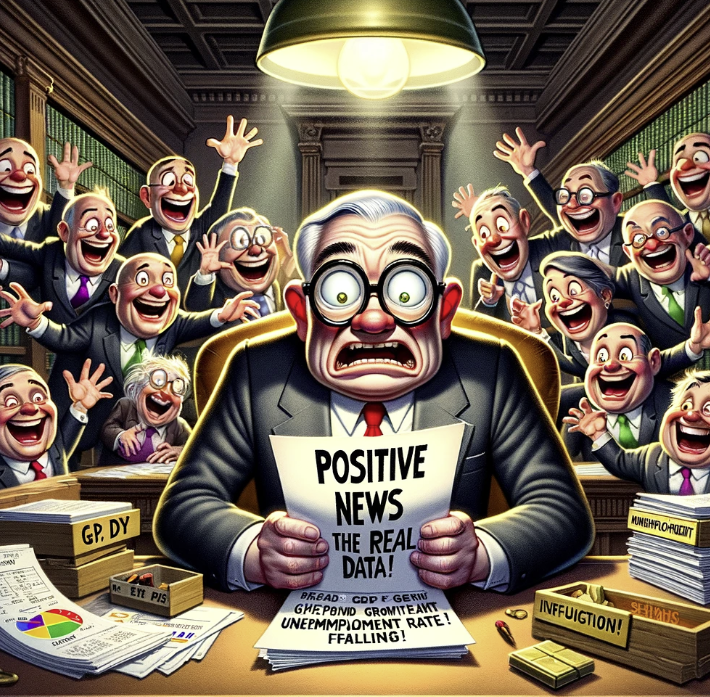
By Michael O’Neill
“Optimus Prime is the leader of the Autobots and defender of Earth against the evil Decepticons. His lesser-known twin brother, Optimist Prime, has a less heroic role, which is to defend those expecting US interest rate cuts from the excessive caution of Fed Chair Jerome Powell.
Mr. Powell opened his press conference on January 31 by boasting that the economy has made good progress toward the Fed’s mandated goals of maximum employment and stable prices noting that inflation had eased from its highs without a significant increase in unemployment.
He humble-bragged about how the Fed’s “strong actions” moved the policy rate “well into restrictive territory,” which cooled economic activity and inflation., and then appeared to declare victory. He said, “We believe that our policy rate is likely at its peak for this tightening cycle and that, if the economy evolves broadly as expected, it will likely be appropriate to begin dialing back policy restraint at some point this year.
That sure sounded like he was setting the stage for a March rate cut announcement. But he wasn’t.”

The Fed left interest rates unchanged and warned “The Committee does not anticipate reducing the target range until greater confidence is achieved that inflation is sustainably trending towards the 2 percent objective.”
That’s called Decidophobia—the fear of making decisions. (The term was coined by Princeton philosopher Walter Kaufmann in 1973).
It is not surprising that the policymakers are gun-shy. The Jerome Powell-led Fed thoroughly blew their post-pandemic inflation response. They harped on transitory inflation so much it became ingrained in their policy outlook. They greatly underestimated the impact of supply chain disruptions and somehow failed to equate the impact of unprecedented and massive government stimulus packages on the spending power of people who were finally freed from pandemic lockdown restrictions.
Those errors fueled an inflation spiral and likely forced the Fed to hike rates higher and more aggressively than otherwise would have been the case. Many private sector economists realized the burgeoning inflation issue and were vocal with their opinions, but not the Fed.
The FOMC members believe they are the smartest people in any room, and they have the education to prove it. The Board of Governors and the 12 regional offices employ over 400 Ph.D. economists. The majority obviously all agreed that inflation was transitory and very likely many of the same economists were the ones who couldn’t explain why inflation was persistently below the Fed’s 2.0% target between 2008 and 2020.
Blame it on the models. The Bank of Canada is.”

Not runway models but economic forecasting tools. Bank of Canada Governor Tiff Macklem delivered his last speech of 2023 on December 12. He admitted, in a rather convoluted way, that the BoC’s forecasting was poor. He blamed the errors on a confluence of unforeseen factors. Primarily, the persistence of supply chain disruptions, exacerbated by the global pandemic. These issues were further compounded by geopolitical tensions, notably Russia’s invasion of Ukraine, which introduced additional volatility into the global economy. Moreover, the forecasts did not fully anticipate the rapid resurgence in consumer demand following the easing of pandemic-related restrictions, particularly after the Omicron wave. This unexpected spike in demand, juxtaposed against the backdrop of constrained supply capacities, fueled inflationary pressures beyond the Bank’s initial projections.
The Bank’s models, which traditionally relied on historical data and established economic theories, struggled to account for the unique and concurrent shocks to both supply and demand sides of the economy.
Those models are being replaced in what the BoC describes as the largest revamp in nearly two decades. Nevertheless it wont’ stop policymakers from making predictions near term: “Cause the players gonna play, play, play, play, play. And the forecasters gonna forecast, cast, cast, cast, cast, cast.”
To that end, Governor Macklem and Fed President Powell are on the same page. Mr. Macklem addressed the House of Commons Standing Committee on Finance on February 1. He delivered a cautious yet proactive stance on inflation and interest rates, emphasizing the importance of monitoring economic indicators closely.
He said that the decision to maintain the policy interest rate at 5% reflected the BoC’s commitment to stabilizing prices, despite ongoing inflationary pressures. He added, “monetary policy is working to relieve price pressures, and we need to stay the course.” He repeated that policymakers believe future rate discussions will be about how long to maintain the current restrictive stance rather than whether it is restrictive enough.
That should mean Canadian rates are headed lower, but the BoC also has a case of Decidophobia. Macklem also said, “That doesn’t mean we have ruled out further policy rate increases. If new developments push inflation higher, we may still need to raise rates.”
Even so, USDCAD direction will be determined by the outlook for US rates and US bond traders are actively managing that view today. The US 10-year Treasury yield has dropped from 4.10% on Wednesday to 3.817%, which suggests bond traders are care more that rates are going lower than they do with the timing of rate cuts.
Rate Optimism Prime has thrown Fed caution to the wind.





